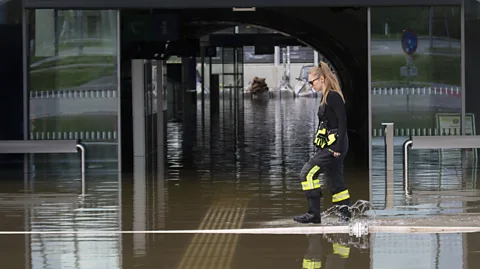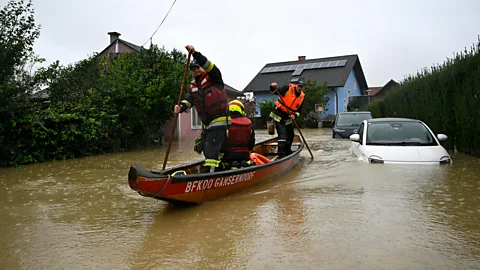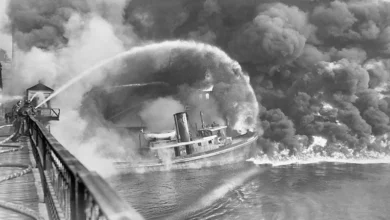‘Our plan worked’: How Vienna prepared itself for a 5,000-year flood

Storm Boris is the latest deluge in one of the most flood-plagued periods in Europe in the past 500 years, but one city escaped relatively unscathed. The steps Vienna took to prepare for extreme rainfall may hold lessons for how other cities can face deluges to come.
When record rainfall brought by Storm Boris doused Vienna on 15 September, the impact looked dramatic: flooded roads, evacuated houses, a gentle stream that turned into a roaring torrent. In the space of only five days, between twice and five times as much rain fell on the city and other parts of Austria as in an entire average month of September.
And yet, considering the onslaught of water, “we got away quite lightly”, noted a Viennese journalist, referring to reports of an estimated ten lightly injured people, and 15 evacuated houses in the city. “On the whole, the [city’s] ingenious flood management system resisted the masses of water,” concluded another local journalist.
In fact, evidence from previous big floods suggests that a number of protective strategies used by Vienna, and Austria more generally, are proving effective – and offering vital lessons to others battling increasingly extreme weather.
“Austria has really invested in flood management over the past decades, not least because we had two big floods, in 2002 and 2013,” says Günter Blöschl, a hydrologist and director of the Centre for Water Resource Systems of the Vienna University of Technology, who has helped shape Austria’s flood risk management strategy.
In Vienna, a flood defence system developed decades ago has played a crucial role in protecting the city, Blöschl explains.
“Vienna’s flood defence system is designed to cope with a flood discharge of 14,000 cubic metres per second – that’s equivalent to a 5,000-year flood,” he says. A flood of that size last occurred in 1501, he adds. During the flood over the weekend, around 10,000 cubic metres per second flowed through Vienna’s waterways, “significantly below the system’s 14,000-cubic-metre capacity,” he adds. “Without this system, there would have been widespread flooding.”

One cornerstone of this flood defence system is an artificial island, the Danube Island, and a flood control channel, the New Danube. Both were built in the 1970s, in reaction to a powerful flood in 1954 that had overwhelmed existing defences. The New Danube is usually closed by weirs, creating a kind of lake. “The weirs are opened before the flood arrives, and for three, four days, the channel takes in flowing water,” relieving Vienna’s main river, the Danube, Blöschl says.
The system was put to a dramatic test in 2013, when the Upper Danube Basin experienced one of the largest floods in the past two centuries. The Danube’s flood discharge in Vienna reached around 11,000 cubic metres per second, but major damage was avoided due to the city’s flood defence system, according to a report by the city. “Not a single household was threatened in Vienna, compared with 400,000 households across Austria,” the report stated.
That does not mean the system wholly contains big floods, however. During the big flood last weekend, the Wienfluss, a smaller river in Vienna, swelled and spilled onto the tracks of an underground train, and public transport has been interrupted as a result.
The damage we’ve avoided is far higher than the investment in flood protection. It’s a success story – Günter Blöschl
Austria as a whole has also ramped up its defences. It invests around €60m ($67m and £50m) a year in flood protection measures – and has seen a reduction in the devastation caused, according to official estimates. The protective strategy includes regular drills for emergency measures such as mobile walls, put up to hold back masses of water; and a more sophisticated and accurate forecasting system.
According to an official evaluation, the big flood in 2002 caused €3bn ($3.6bn, £2.5bn) in damage in all of Austria. Even though the 2013 flood was also big, the damage it caused was much less, estimated at around €866m ($967m, £727m), thanks to the flood protection measures. Data also backs up the accuracy of the forecasts: after the flood over the 13 September 2024 weekend, Austria’s weather service found that the actual rainfall was in line with the expected amount.
Looking at the impact of the flood last weekend, “We’ve seen that it’s been worth it,” Blöschl says of the measures. “The damage we’ve avoided is far higher than the investment in flood protection. It’s a success story.”

Managing the huge volumes of water during such a big flood is especially difficult as there are now fewer floodplains, where the water can safely expand without threatening humans or their property. Instead, there are now towns and farms on the previously uninhabited floodplains – which are defined as areas alongside rivers that are naturally prone to flooding.
In 1899, when Vienna experienced a flood of a similar size to the one in 2013, “there were basically no dams,” he says. “But there were almost 1,000 square kilometres (386 sq miles) of floodplains [upstream of Vienna]. They held back a lot of the water. Those aren’t there anymore, so with the same rainfall, you get a lot more discharge into the Danube in Vienna.” With more water flowing into the city, the rivers swell more, and are more likely to spill over unless they are contained.
The ‘levee effect’: why dams don’t equal safety
Paradoxically, while dams, levees and other barriers help protect people by holding back the water during a flood, they can actually increase the overall risk in the long run, studies suggest. That’s because they can give people a false sense of safety, and encourage them to settle close to waterways and underestimate the risk of flooding, a phenomenon known as the levee effect. At worst, it can leave them unprepared in an emergency.
In the United States, for example, levee construction is associated with a 62% acceleration in urban expansion in floodplains, compared to a 29% increase in the wider county, according to one study. The studies’ authors warn that this highlights “a clear change in risk perception after levees are built”, but also note that regulation can reduce that push into floodplains.
“Vienna is a good example for the levee effect,” says Blöschl. “When a city is protected, for example through levees, people get a feeling of safety. And then, through urbanisation, the flood risk rises, as that risk is defined as the probability of a flood, times the expected damage. And when more people move into the floodplains, that expected damage is greater.”
However, preventing people from settling near rivers is difficult, he says – because floods occur rarely, and riversides and floodplains can be attractive settlement areas. In fact, research suggest that around 2 billion people in the world live on floodplains. Research also suggests that people in fact have a short memory when it comes to flooding risk, with public awareness of the danger and how to respond soaring in the wake of a big flood, but then falling fairly quickly.
Flood drills are really important. Unless you prepare with practical exercises, it’s not going to work during emergencies – Günter Blöschl
In Austria, accurate forecasts and flood management drills helped save lives during the most recent flood, not only in Vienna but also in other parts of Austria, Blöschl says. “We had flood drills at every level, for the firefighters and the military. Unless you prepare with practical exercises, it’s not going to work during emergencies. My message is that flood management drills are a really important element,” he says.
Emergency responders practiced how to put up mobile walls to hold back the flood, for example. “If that doesn’t run like clockwork, you’re not going to get them up in time” before the water comes, he says. “A lot can go wrong – there can be parts missing, and if there’s even a tiny gap, the water gets through. So you have to practise, and they did, and it worked.”
Accurate forecasts also helped decide where dams were at risk of being breached, and where people had to be evacuated, he adds.

Super-charged storms
Being prepared is particularly important, research suggests, as climate change is leading to more intense rain storms and more floods in some areas of Europe. One reason is that the warmer air holds more moisture and energy, which fuels powerful storms – such as Storm Boris. Summer 2024 was the hottest on record for Europe and globally.
“This event was intensified by climate change, particularly the warming of the Mediterranean sea,” says Blöschl, pointing to record-breaking Mediterranean Sea surface temperatures this summer. Because of this unusually warm Mediterranean summer, Storm Boris “was able to take up more energy and water”, he explains.
There is other evidence that such warming is super-charging storms. A study found that a record-breaking marine heatwave and human-made climate change substantially contributed to the development of an extremely powerful storm over the Mediterranean Sea in August 2022.
“All the studies (based on numerical simulations or on statistical analysis) seem to confirm that especially the warming of the sea surface is responsible for producing an increase in the intensity of these storms,” says Mario Marcello Miglietta, a research director at the Institute of Atmospheric Sciences and Climate (CNR-ISAC) in Padua, Italy, and one of the authors of the study. “In the climate conditions of a few decades ago, [these storms] would have not formed.”
Another reason for the rise in floods in northern Europe is a broader northward shift in global rainfall, because of changing pressure between the Arctic and the equator, as the two are warming at different rates, Blöschl explains. The Arctic is warming faster than the equator because the melting ice results in the surface being less reflective and instead, more absorbent of sunlight, which reinforces the warming effect, he says.
“All the countries north of the Alps, so for example, Austria, Germany, France, the British Isles, the West Coast of Scandinavia, have seen a rise in floods over the past 30 years,” says Blöschl. His research with colleagues suggests that the past three decades have been among the most flood-plagued periods in Europe in the past 500 years.

In 2021, shocking images of torrents of water ripping through western European towns, fuelled by record-breaking rainfall, showed the impact of such disasters and also raised questions over how to prepare for them. More than 200 people died in that flood, including 184 people in Germany, prompting soul-searching over whether such a wealthy country could not have protected its people better. In 2024, a German report on lessons from that disaster recommended giving clearer warnings with specific action to be taken, including maps and chart to help people understand exactly what to do and distributing the warnings in many different ways to reach as many people as possible. This was after a survey of survivors in the German disaster zone revealed that a third of respondents did not receive any warning, and of those who were warned, 85% did not expect very severe flooding and almost half did not know what to do.
In the climate conditions of a few decades ago, these storms would have not formed – Mario Marcello Miglietta
And while Vienna may have resisted the most recent flood relatively well, it wreaked havoc in many parts of central Europe – causing ‘a catastrophe of epic proportions’, in the words of a Romanian mayor. More than 20 people died and thousands of people were evacuated, including the entire town of Nysa in Poland – more than 40,000 people. In Austria, farmers saw their harvests destroyed, with millions of euros of damage.
Research suggests that sharing lessons across borders is vital in helping European countries prepare for future extreme weather. In 2023, a team of European scientists who analysed historic megafloods found that 95.5% of megafloods could have been anticipated based on previous events in other, comparable places in Europe. The scientists emphasised that while megafloods may be rare in each country, they are more common across the whole region, concluding that “local surprises are not surprising at the continental scale”.
In fact, record-breaking rainfall and widespread flooding has become a regular occurrence in Europe, and an estimated one in eight Europeans lives in areas potentially vulnerable to flooding.
Based on models projecting increased and more extreme rainfall in northern Europe, leading to more floods, Blöschl says: “The prognosis is that it’s going to continue like this”.









